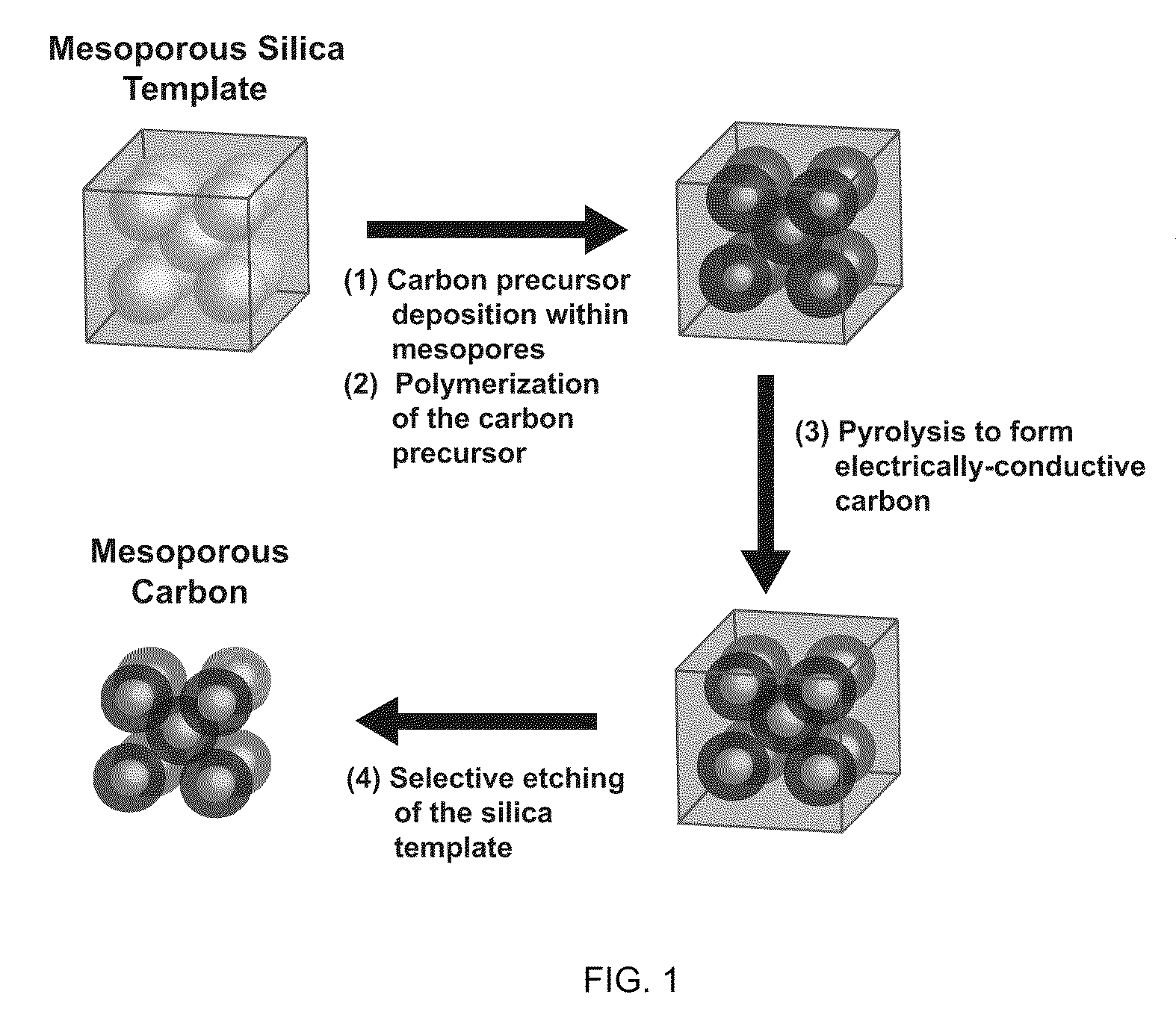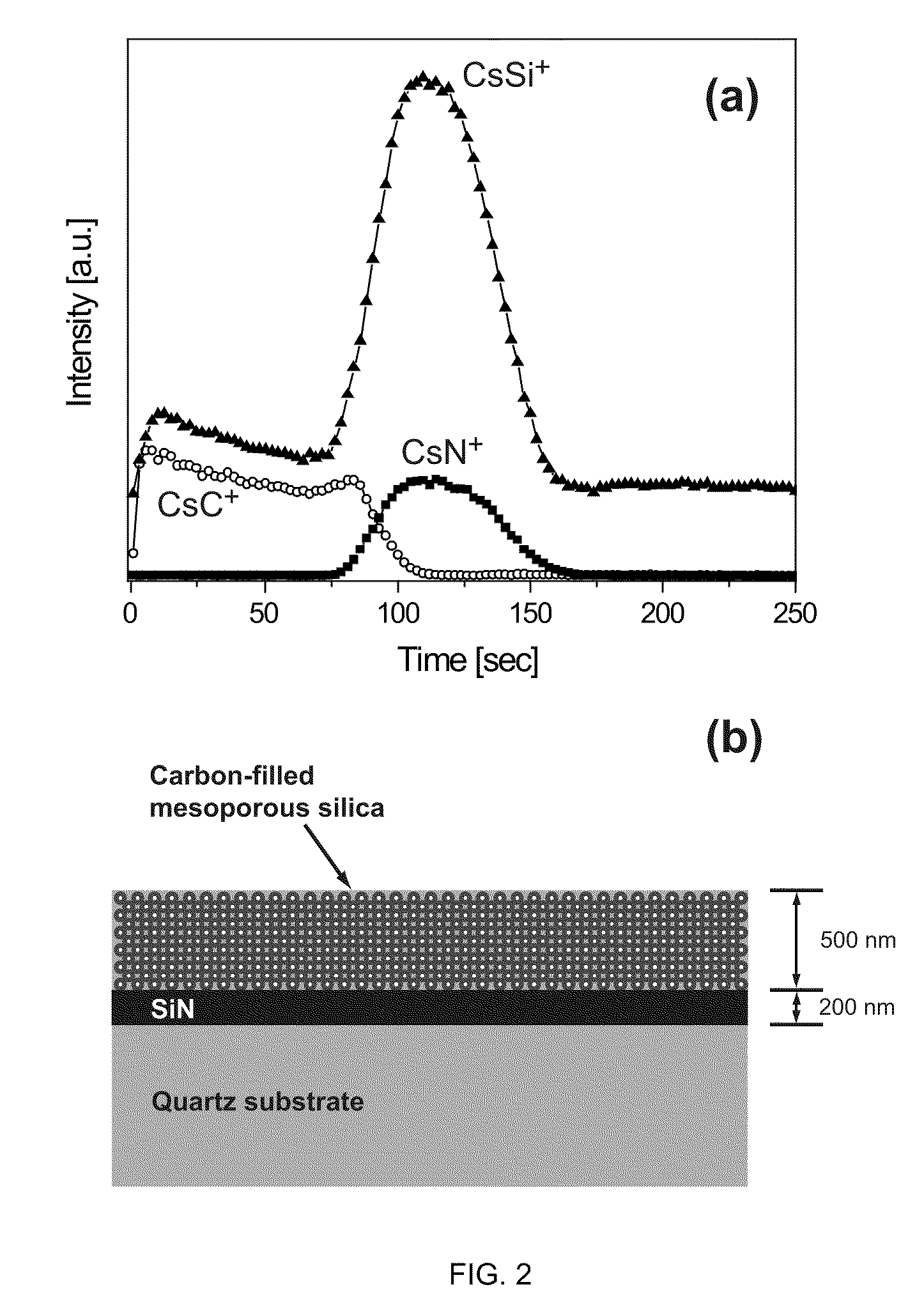Carbon materials with interconnected pores
a technology of carbon materials and pores, applied in the field of mesoporous carbon materials synthesis, can solve the problems of low carbonization temperature required, poor electrical conductivity of films, and unprecedented mesoporous carbon materials, and achieve high proton conductivity, improve interfacial contact, and improve the surface area and performance of electrocatalysts and capacitors.
- Summary
- Abstract
- Description
- Claims
- Application Information
AI Technical Summary
Benefits of technology
Problems solved by technology
Method used
Image
Examples
example 1
Template Film Synthesis
[0053]Mesostructured silica films possessing body-centered-cubic Im 3 m ordering were prepared using the procedures described in Zhao et al., Adv. Mater. 1998, 10, 1380-1385 and Alberius et al., Chem. Mater. 2002, 14, 3284-3294, both of which are incorporated herein by reference.
[0054]These films can be prepared using amphiphilic block-copolymer species as structure-directing and film forming agents. This was achieved by dip-coating a precursor solution of poly(ethyleneoxide)-b-poly(propyleneoxide)-b-poly(ethyleneoxide) triblock copolymer species, e.g., Pluronic™ F127 (EO106PO70EO106) in the presence of a hydrolyzed silica species under acidic conditions onto a polished silicon substrate at room temperature. As the substrate was withdrawn from the precursor solution, volatile solvent components evaporated from the deposited film, thereby promoting self-assembly of the triblock copolymer species, along with co-assembly and subsequent formation of a densely cros...
example 2
Mesoporous Carbon Film Synthesis
[0056]The pore dimensions and structural ordering can be adjusted according to the selection of the structure-directing low-molecular-weight surfactant, block-copolymer, or colloidal species used to prepare the porous template. Mesoporous silica thin film templates were specifically synthesized in the same manner as described in Example 1. However, due to the need for high temperature (≧900° C.) treatment of the films, the block copolymer / silica precursor solution was dip-coated onto polished quartz substrates coated with a 200 nm thick layer of SiN instead of polished silicon wafers. The presence of the SiN intermediate layer serves to reduce cracking of the mesoporous silica film during the high temperature treatment and to promote adhesion and prevent lift-off of the carbon film after etching the silica template. The supported mesostructured silica films were calcined at 450° C. in air to remove the structure-directing triblock copolymer species.
[0...
example 3
Characterization
[0058]X-ray diffraction, transmission electron microscopy, and nitrogen sorption techniques allowed for full characterization of the mesostructural ordering in the films. X-ray diffraction patterns were collected using a Phillips X'PERT MPD Thin Film Powder Diffractometer using 1.54 Å Cu Kα, radiation. Transmission electron microscopy (TEM) samples were prepared by Focused Ion Beam (FIB) milling of a 200 nm thick cross-sectional slice of the mesoporous carbon thin film using a FEI DB235 Dual-Beam Focused Ion Beam system with a gallium ion beam accelerated at 30 kV. Prior to cross-sectioning, a layer of platinum was deposited on the film surface to reduce beam damage to the sample during milling. The TEM sample was transferred to a holey carbon grid by plucking the sample with a sharpened glass needle. TEM images were collected on a FEI T20 microscope operating at 200 kV. Nitrogen sorption isotherms were collected with a TriStar 3000 Gas Adsorption Analyzer. The mesop...
PUM
 Login to View More
Login to View More Abstract
Description
Claims
Application Information
 Login to View More
Login to View More - R&D
- Intellectual Property
- Life Sciences
- Materials
- Tech Scout
- Unparalleled Data Quality
- Higher Quality Content
- 60% Fewer Hallucinations
Browse by: Latest US Patents, China's latest patents, Technical Efficacy Thesaurus, Application Domain, Technology Topic, Popular Technical Reports.
© 2025 PatSnap. All rights reserved.Legal|Privacy policy|Modern Slavery Act Transparency Statement|Sitemap|About US| Contact US: help@patsnap.com



